Organisational Theory and Practice: Analysing Leadership and Culture
VerifiedAdded on 2023/06/18
|13
|4138
|146
Report
AI Summary
This report provides an in-depth analysis of organisational theory and practice, focusing on managerial styles, leadership effectiveness, and the impact of power, influence, and conflict within an organisation, specifically Marks & Spencer. It explores the application of the Managerial Grid Model to understand different leadership styles and examines the steps a CEO can take to implement organisational changes effectively, referencing Kotter’s 8-Step Change Model. The report further discusses various leadership styles, highlighting the suitability of democratic leadership for Marks & Spencer, and investigates the effects of power dynamics, influence, and conflict on the company’s performance. Additionally, it outlines various motivation strategies and concludes with recommendations to enhance organisational performance, supported by corporate examples and relevant literature. Desklib offers a wealth of resources including similar reports and solved assignments.
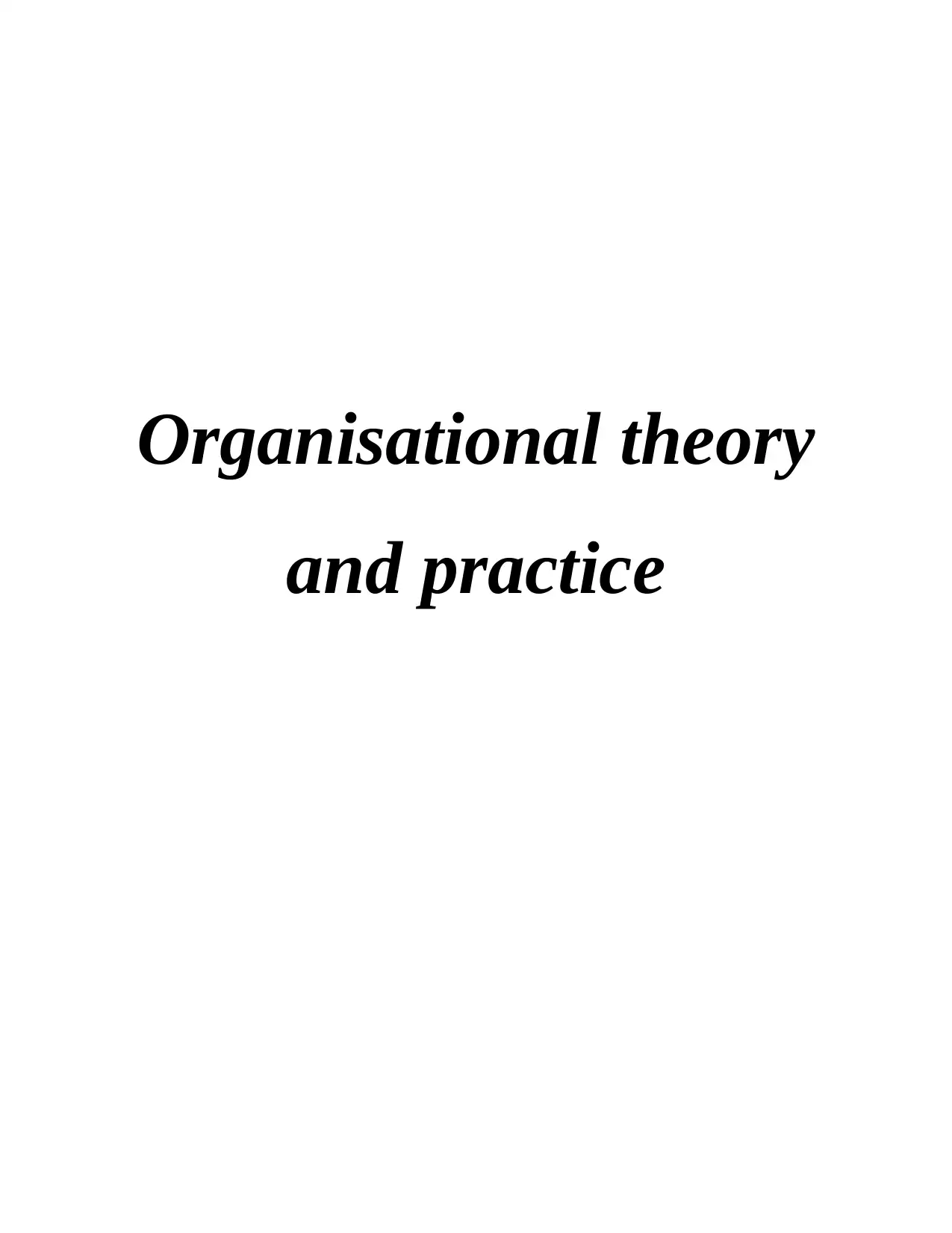
Organisational theory
and practice
and practice
Paraphrase This Document
Need a fresh take? Get an instant paraphrase of this document with our AI Paraphraser
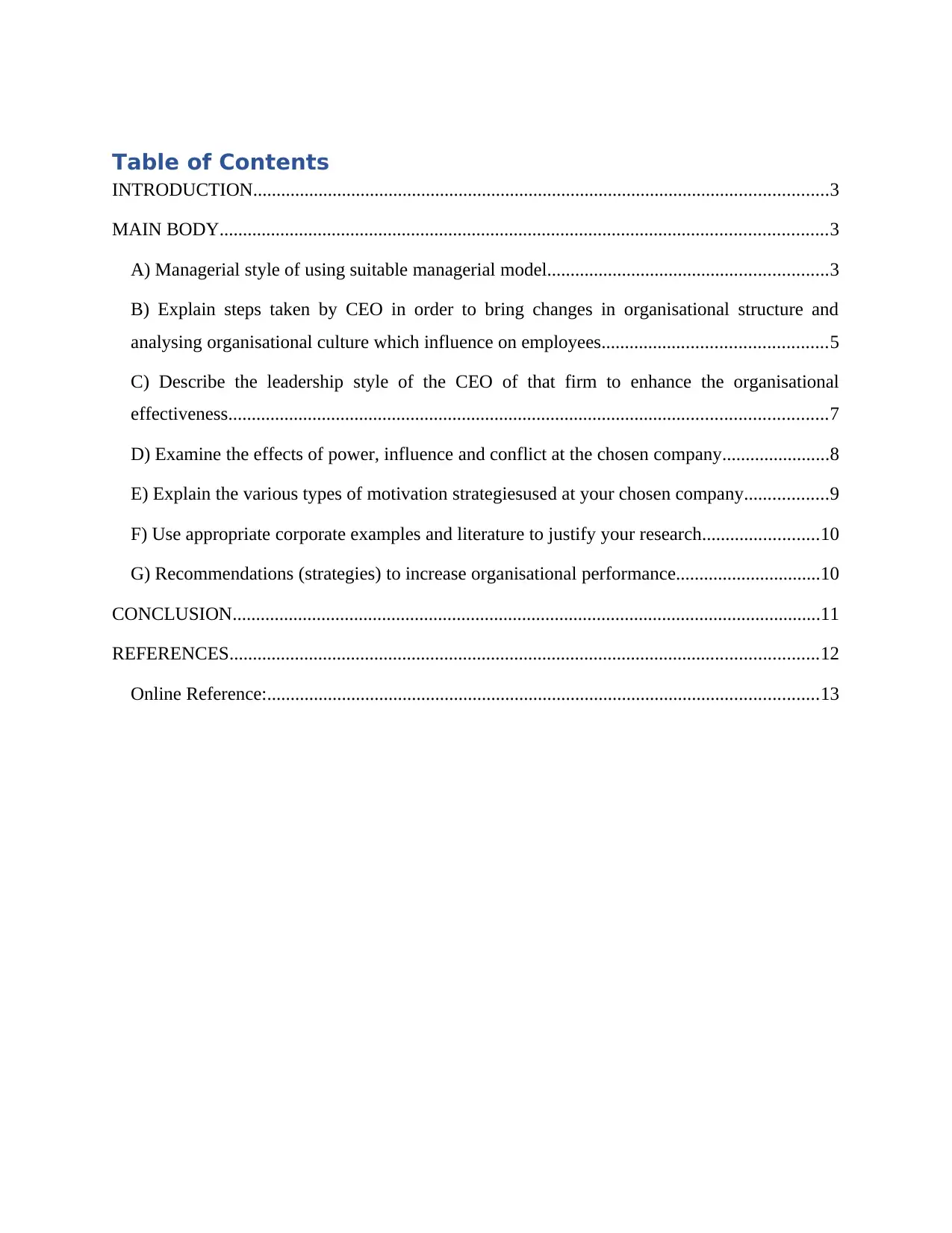
Table of Contents
INTRODUCTION...........................................................................................................................3
MAIN BODY..................................................................................................................................3
A) Managerial style of using suitable managerial model............................................................3
B) Explain steps taken by CEO in order to bring changes in organisational structure and
analysing organisational culture which influence on employees................................................5
C) Describe the leadership style of the CEO of that firm to enhance the organisational
effectiveness................................................................................................................................7
D) Examine the effects of power, influence and conflict at the chosen company.......................8
E) Explain the various types of motivation strategiesused at your chosen company..................9
F) Use appropriate corporate examples and literature to justify your research.........................10
G) Recommendations (strategies) to increase organisational performance...............................10
CONCLUSION..............................................................................................................................11
REFERENCES..............................................................................................................................12
Online Reference:......................................................................................................................13
INTRODUCTION...........................................................................................................................3
MAIN BODY..................................................................................................................................3
A) Managerial style of using suitable managerial model............................................................3
B) Explain steps taken by CEO in order to bring changes in organisational structure and
analysing organisational culture which influence on employees................................................5
C) Describe the leadership style of the CEO of that firm to enhance the organisational
effectiveness................................................................................................................................7
D) Examine the effects of power, influence and conflict at the chosen company.......................8
E) Explain the various types of motivation strategiesused at your chosen company..................9
F) Use appropriate corporate examples and literature to justify your research.........................10
G) Recommendations (strategies) to increase organisational performance...............................10
CONCLUSION..............................................................................................................................11
REFERENCES..............................................................................................................................12
Online Reference:......................................................................................................................13
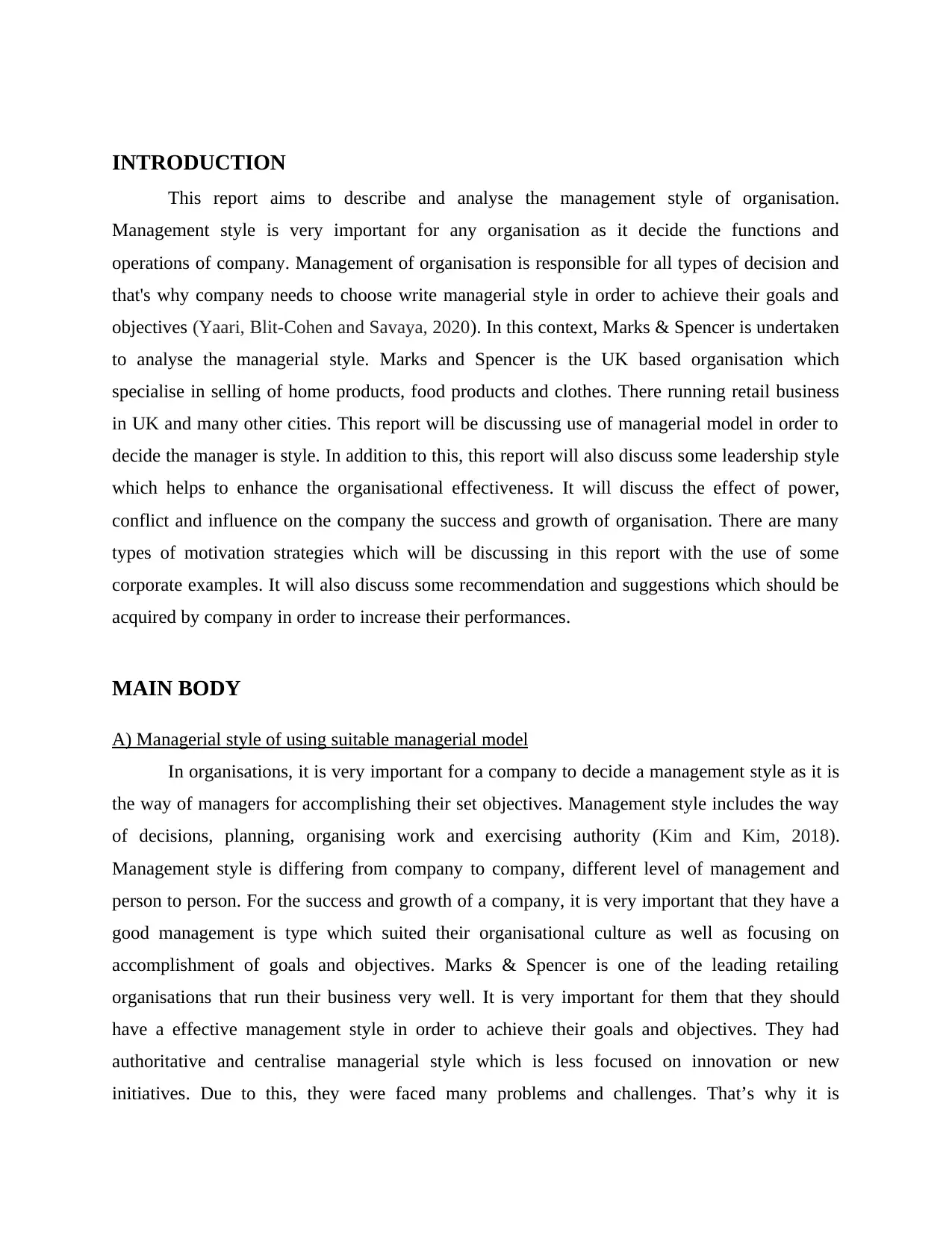
INTRODUCTION
This report aims to describe and analyse the management style of organisation.
Management style is very important for any organisation as it decide the functions and
operations of company. Management of organisation is responsible for all types of decision and
that's why company needs to choose write managerial style in order to achieve their goals and
objectives (Yaari, Blit-Cohen and Savaya, 2020). In this context, Marks & Spencer is undertaken
to analyse the managerial style. Marks and Spencer is the UK based organisation which
specialise in selling of home products, food products and clothes. There running retail business
in UK and many other cities. This report will be discussing use of managerial model in order to
decide the manager is style. In addition to this, this report will also discuss some leadership style
which helps to enhance the organisational effectiveness. It will discuss the effect of power,
conflict and influence on the company the success and growth of organisation. There are many
types of motivation strategies which will be discussing in this report with the use of some
corporate examples. It will also discuss some recommendation and suggestions which should be
acquired by company in order to increase their performances.
MAIN BODY
A) Managerial style of using suitable managerial model
In organisations, it is very important for a company to decide a management style as it is
the way of managers for accomplishing their set objectives. Management style includes the way
of decisions, planning, organising work and exercising authority (Kim and Kim, 2018).
Management style is differing from company to company, different level of management and
person to person. For the success and growth of a company, it is very important that they have a
good management is type which suited their organisational culture as well as focusing on
accomplishment of goals and objectives. Marks & Spencer is one of the leading retailing
organisations that run their business very well. It is very important for them that they should
have a effective management style in order to achieve their goals and objectives. They had
authoritative and centralise managerial style which is less focused on innovation or new
initiatives. Due to this, they were faced many problems and challenges. That’s why it is
This report aims to describe and analyse the management style of organisation.
Management style is very important for any organisation as it decide the functions and
operations of company. Management of organisation is responsible for all types of decision and
that's why company needs to choose write managerial style in order to achieve their goals and
objectives (Yaari, Blit-Cohen and Savaya, 2020). In this context, Marks & Spencer is undertaken
to analyse the managerial style. Marks and Spencer is the UK based organisation which
specialise in selling of home products, food products and clothes. There running retail business
in UK and many other cities. This report will be discussing use of managerial model in order to
decide the manager is style. In addition to this, this report will also discuss some leadership style
which helps to enhance the organisational effectiveness. It will discuss the effect of power,
conflict and influence on the company the success and growth of organisation. There are many
types of motivation strategies which will be discussing in this report with the use of some
corporate examples. It will also discuss some recommendation and suggestions which should be
acquired by company in order to increase their performances.
MAIN BODY
A) Managerial style of using suitable managerial model
In organisations, it is very important for a company to decide a management style as it is
the way of managers for accomplishing their set objectives. Management style includes the way
of decisions, planning, organising work and exercising authority (Kim and Kim, 2018).
Management style is differing from company to company, different level of management and
person to person. For the success and growth of a company, it is very important that they have a
good management is type which suited their organisational culture as well as focusing on
accomplishment of goals and objectives. Marks & Spencer is one of the leading retailing
organisations that run their business very well. It is very important for them that they should
have a effective management style in order to achieve their goals and objectives. They had
authoritative and centralise managerial style which is less focused on innovation or new
initiatives. Due to this, they were faced many problems and challenges. That’s why it is
⊘ This is a preview!⊘
Do you want full access?
Subscribe today to unlock all pages.

Trusted by 1+ million students worldwide
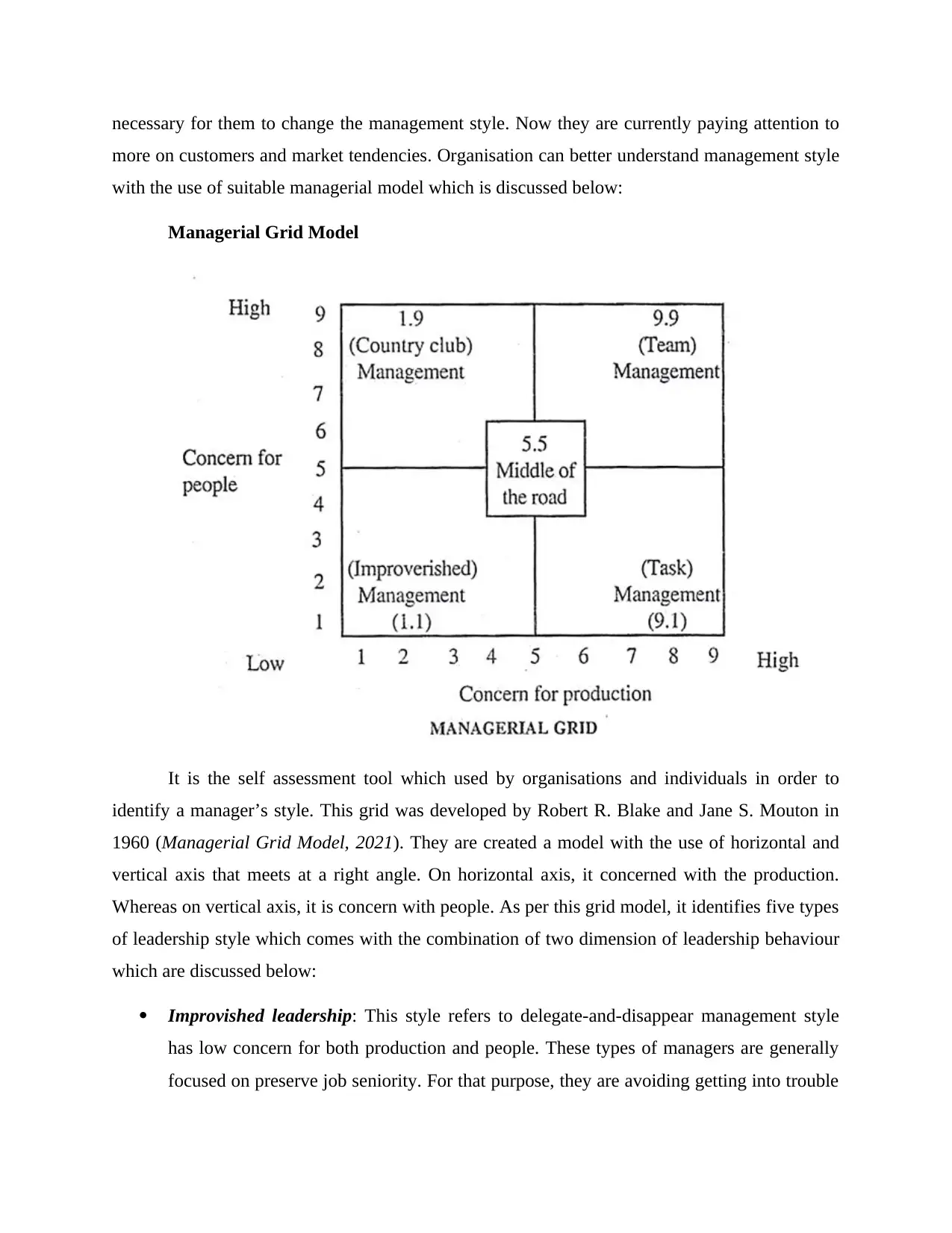
necessary for them to change the management style. Now they are currently paying attention to
more on customers and market tendencies. Organisation can better understand management style
with the use of suitable managerial model which is discussed below:
Managerial Grid Model
It is the self assessment tool which used by organisations and individuals in order to
identify a manager’s style. This grid was developed by Robert R. Blake and Jane S. Mouton in
1960 (Managerial Grid Model, 2021). They are created a model with the use of horizontal and
vertical axis that meets at a right angle. On horizontal axis, it concerned with the production.
Whereas on vertical axis, it is concern with people. As per this grid model, it identifies five types
of leadership style which comes with the combination of two dimension of leadership behaviour
which are discussed below:
Improvished leadership: This style refers to delegate-and-disappear management style
has low concern for both production and people. These types of managers are generally
focused on preserve job seniority. For that purpose, they are avoiding getting into trouble
more on customers and market tendencies. Organisation can better understand management style
with the use of suitable managerial model which is discussed below:
Managerial Grid Model
It is the self assessment tool which used by organisations and individuals in order to
identify a manager’s style. This grid was developed by Robert R. Blake and Jane S. Mouton in
1960 (Managerial Grid Model, 2021). They are created a model with the use of horizontal and
vertical axis that meets at a right angle. On horizontal axis, it concerned with the production.
Whereas on vertical axis, it is concern with people. As per this grid model, it identifies five types
of leadership style which comes with the combination of two dimension of leadership behaviour
which are discussed below:
Improvished leadership: This style refers to delegate-and-disappear management style
has low concern for both production and people. These types of managers are generally
focused on preserve job seniority. For that purpose, they are avoiding getting into trouble
Paraphrase This Document
Need a fresh take? Get an instant paraphrase of this document with our AI Paraphraser
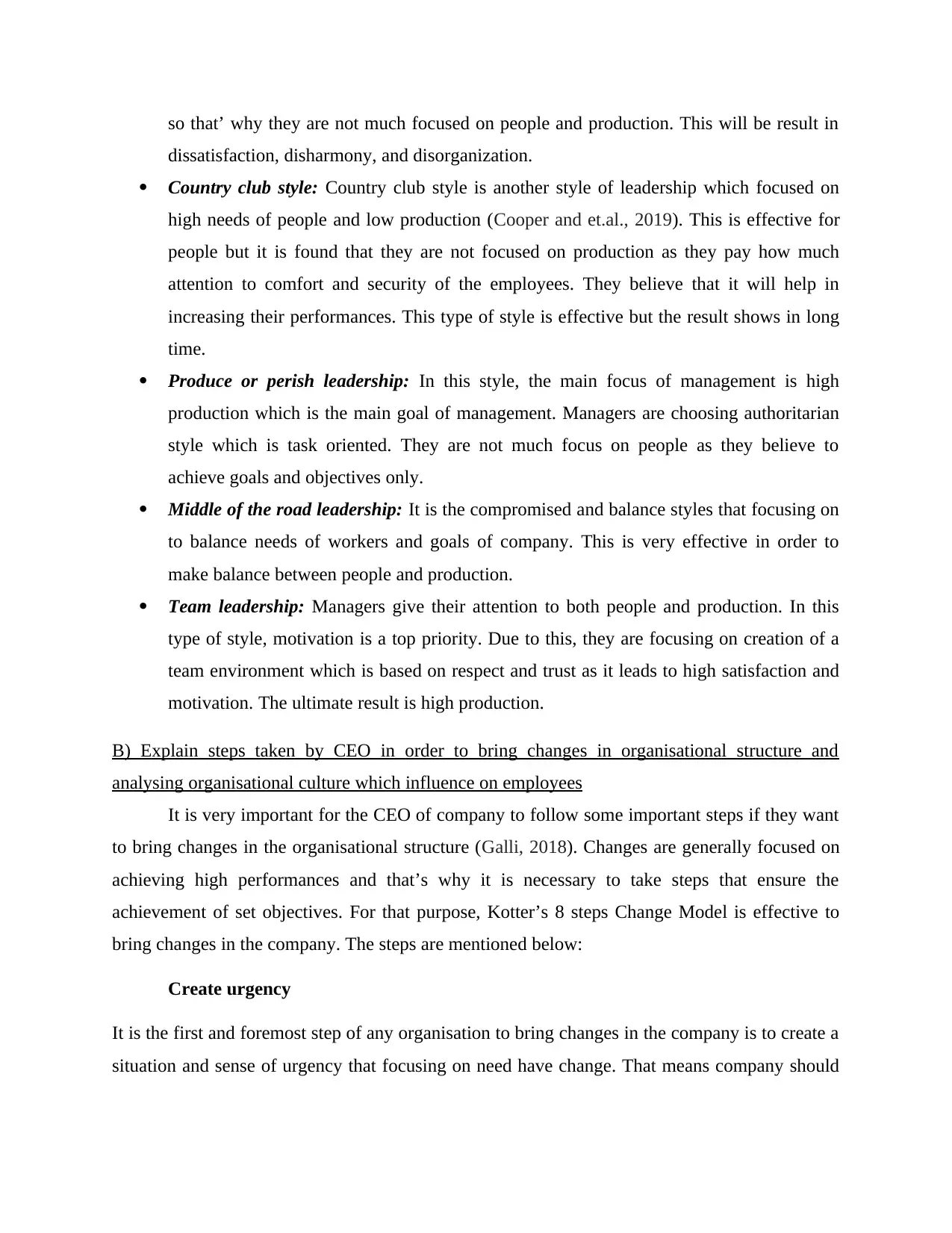
so that’ why they are not much focused on people and production. This will be result in
dissatisfaction, disharmony, and disorganization.
Country club style: Country club style is another style of leadership which focused on
high needs of people and low production (Cooper and et.al., 2019). This is effective for
people but it is found that they are not focused on production as they pay how much
attention to comfort and security of the employees. They believe that it will help in
increasing their performances. This type of style is effective but the result shows in long
time.
Produce or perish leadership: In this style, the main focus of management is high
production which is the main goal of management. Managers are choosing authoritarian
style which is task oriented. They are not much focus on people as they believe to
achieve goals and objectives only.
Middle of the road leadership: It is the compromised and balance styles that focusing on
to balance needs of workers and goals of company. This is very effective in order to
make balance between people and production.
Team leadership: Managers give their attention to both people and production. In this
type of style, motivation is a top priority. Due to this, they are focusing on creation of a
team environment which is based on respect and trust as it leads to high satisfaction and
motivation. The ultimate result is high production.
B) Explain steps taken by CEO in order to bring changes in organisational structure and
analysing organisational culture which influence on employees
It is very important for the CEO of company to follow some important steps if they want
to bring changes in the organisational structure (Galli, 2018). Changes are generally focused on
achieving high performances and that’s why it is necessary to take steps that ensure the
achievement of set objectives. For that purpose, Kotter’s 8 steps Change Model is effective to
bring changes in the company. The steps are mentioned below:
Create urgency
It is the first and foremost step of any organisation to bring changes in the company is to create a
situation and sense of urgency that focusing on need have change. That means company should
dissatisfaction, disharmony, and disorganization.
Country club style: Country club style is another style of leadership which focused on
high needs of people and low production (Cooper and et.al., 2019). This is effective for
people but it is found that they are not focused on production as they pay how much
attention to comfort and security of the employees. They believe that it will help in
increasing their performances. This type of style is effective but the result shows in long
time.
Produce or perish leadership: In this style, the main focus of management is high
production which is the main goal of management. Managers are choosing authoritarian
style which is task oriented. They are not much focus on people as they believe to
achieve goals and objectives only.
Middle of the road leadership: It is the compromised and balance styles that focusing on
to balance needs of workers and goals of company. This is very effective in order to
make balance between people and production.
Team leadership: Managers give their attention to both people and production. In this
type of style, motivation is a top priority. Due to this, they are focusing on creation of a
team environment which is based on respect and trust as it leads to high satisfaction and
motivation. The ultimate result is high production.
B) Explain steps taken by CEO in order to bring changes in organisational structure and
analysing organisational culture which influence on employees
It is very important for the CEO of company to follow some important steps if they want
to bring changes in the organisational structure (Galli, 2018). Changes are generally focused on
achieving high performances and that’s why it is necessary to take steps that ensure the
achievement of set objectives. For that purpose, Kotter’s 8 steps Change Model is effective to
bring changes in the company. The steps are mentioned below:
Create urgency
It is the first and foremost step of any organisation to bring changes in the company is to create a
situation and sense of urgency that focusing on need have change. That means company should
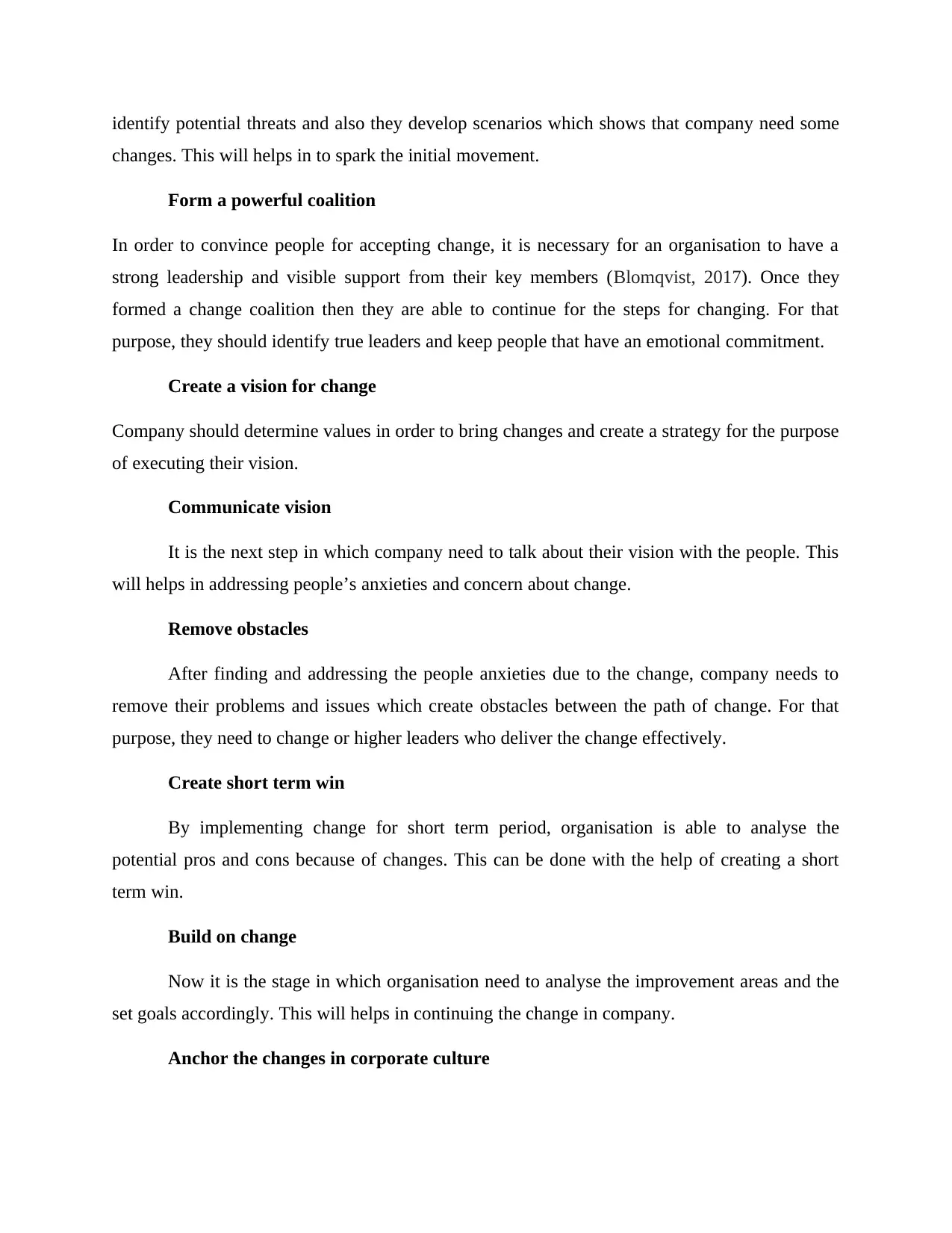
identify potential threats and also they develop scenarios which shows that company need some
changes. This will helps in to spark the initial movement.
Form a powerful coalition
In order to convince people for accepting change, it is necessary for an organisation to have a
strong leadership and visible support from their key members (Blomqvist, 2017). Once they
formed a change coalition then they are able to continue for the steps for changing. For that
purpose, they should identify true leaders and keep people that have an emotional commitment.
Create a vision for change
Company should determine values in order to bring changes and create a strategy for the purpose
of executing their vision.
Communicate vision
It is the next step in which company need to talk about their vision with the people. This
will helps in addressing people’s anxieties and concern about change.
Remove obstacles
After finding and addressing the people anxieties due to the change, company needs to
remove their problems and issues which create obstacles between the path of change. For that
purpose, they need to change or higher leaders who deliver the change effectively.
Create short term win
By implementing change for short term period, organisation is able to analyse the
potential pros and cons because of changes. This can be done with the help of creating a short
term win.
Build on change
Now it is the stage in which organisation need to analyse the improvement areas and the
set goals accordingly. This will helps in continuing the change in company.
Anchor the changes in corporate culture
changes. This will helps in to spark the initial movement.
Form a powerful coalition
In order to convince people for accepting change, it is necessary for an organisation to have a
strong leadership and visible support from their key members (Blomqvist, 2017). Once they
formed a change coalition then they are able to continue for the steps for changing. For that
purpose, they should identify true leaders and keep people that have an emotional commitment.
Create a vision for change
Company should determine values in order to bring changes and create a strategy for the purpose
of executing their vision.
Communicate vision
It is the next step in which company need to talk about their vision with the people. This
will helps in addressing people’s anxieties and concern about change.
Remove obstacles
After finding and addressing the people anxieties due to the change, company needs to
remove their problems and issues which create obstacles between the path of change. For that
purpose, they need to change or higher leaders who deliver the change effectively.
Create short term win
By implementing change for short term period, organisation is able to analyse the
potential pros and cons because of changes. This can be done with the help of creating a short
term win.
Build on change
Now it is the stage in which organisation need to analyse the improvement areas and the
set goals accordingly. This will helps in continuing the change in company.
Anchor the changes in corporate culture
⊘ This is a preview!⊘
Do you want full access?
Subscribe today to unlock all pages.

Trusted by 1+ million students worldwide
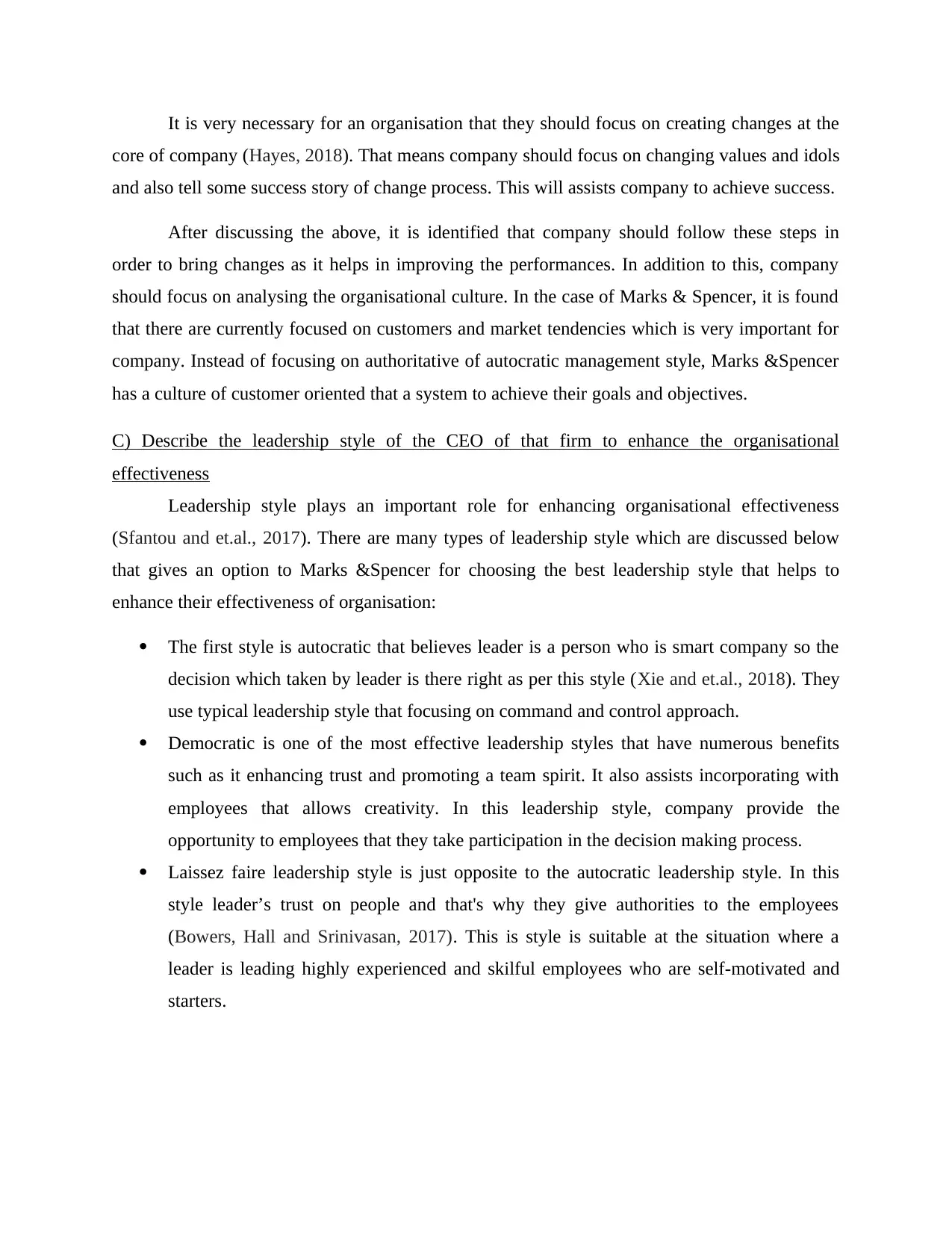
It is very necessary for an organisation that they should focus on creating changes at the
core of company (Hayes, 2018). That means company should focus on changing values and idols
and also tell some success story of change process. This will assists company to achieve success.
After discussing the above, it is identified that company should follow these steps in
order to bring changes as it helps in improving the performances. In addition to this, company
should focus on analysing the organisational culture. In the case of Marks & Spencer, it is found
that there are currently focused on customers and market tendencies which is very important for
company. Instead of focusing on authoritative of autocratic management style, Marks &Spencer
has a culture of customer oriented that a system to achieve their goals and objectives.
C) Describe the leadership style of the CEO of that firm to enhance the organisational
effectiveness
Leadership style plays an important role for enhancing organisational effectiveness
(Sfantou and et.al., 2017). There are many types of leadership style which are discussed below
that gives an option to Marks &Spencer for choosing the best leadership style that helps to
enhance their effectiveness of organisation:
The first style is autocratic that believes leader is a person who is smart company so the
decision which taken by leader is there right as per this style (Xie and et.al., 2018). They
use typical leadership style that focusing on command and control approach.
Democratic is one of the most effective leadership styles that have numerous benefits
such as it enhancing trust and promoting a team spirit. It also assists incorporating with
employees that allows creativity. In this leadership style, company provide the
opportunity to employees that they take participation in the decision making process.
Laissez faire leadership style is just opposite to the autocratic leadership style. In this
style leader’s trust on people and that's why they give authorities to the employees
(Bowers, Hall and Srinivasan, 2017). This is style is suitable at the situation where a
leader is leading highly experienced and skilful employees who are self-motivated and
starters.
core of company (Hayes, 2018). That means company should focus on changing values and idols
and also tell some success story of change process. This will assists company to achieve success.
After discussing the above, it is identified that company should follow these steps in
order to bring changes as it helps in improving the performances. In addition to this, company
should focus on analysing the organisational culture. In the case of Marks & Spencer, it is found
that there are currently focused on customers and market tendencies which is very important for
company. Instead of focusing on authoritative of autocratic management style, Marks &Spencer
has a culture of customer oriented that a system to achieve their goals and objectives.
C) Describe the leadership style of the CEO of that firm to enhance the organisational
effectiveness
Leadership style plays an important role for enhancing organisational effectiveness
(Sfantou and et.al., 2017). There are many types of leadership style which are discussed below
that gives an option to Marks &Spencer for choosing the best leadership style that helps to
enhance their effectiveness of organisation:
The first style is autocratic that believes leader is a person who is smart company so the
decision which taken by leader is there right as per this style (Xie and et.al., 2018). They
use typical leadership style that focusing on command and control approach.
Democratic is one of the most effective leadership styles that have numerous benefits
such as it enhancing trust and promoting a team spirit. It also assists incorporating with
employees that allows creativity. In this leadership style, company provide the
opportunity to employees that they take participation in the decision making process.
Laissez faire leadership style is just opposite to the autocratic leadership style. In this
style leader’s trust on people and that's why they give authorities to the employees
(Bowers, Hall and Srinivasan, 2017). This is style is suitable at the situation where a
leader is leading highly experienced and skilful employees who are self-motivated and
starters.
Paraphrase This Document
Need a fresh take? Get an instant paraphrase of this document with our AI Paraphraser
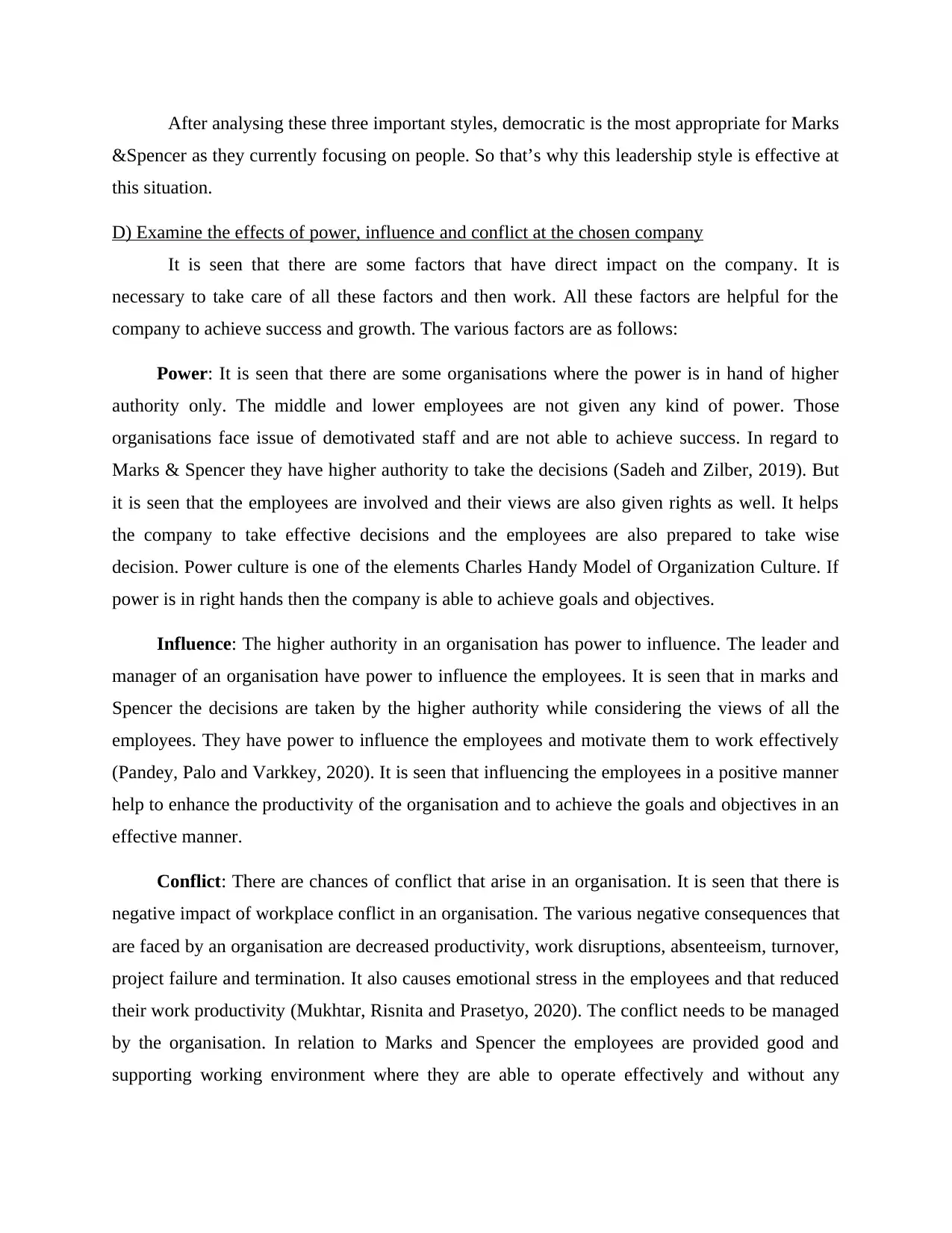
After analysing these three important styles, democratic is the most appropriate for Marks
&Spencer as they currently focusing on people. So that’s why this leadership style is effective at
this situation.
D) Examine the effects of power, influence and conflict at the chosen company
It is seen that there are some factors that have direct impact on the company. It is
necessary to take care of all these factors and then work. All these factors are helpful for the
company to achieve success and growth. The various factors are as follows:
Power: It is seen that there are some organisations where the power is in hand of higher
authority only. The middle and lower employees are not given any kind of power. Those
organisations face issue of demotivated staff and are not able to achieve success. In regard to
Marks & Spencer they have higher authority to take the decisions (Sadeh and Zilber, 2019). But
it is seen that the employees are involved and their views are also given rights as well. It helps
the company to take effective decisions and the employees are also prepared to take wise
decision. Power culture is one of the elements Charles Handy Model of Organization Culture. If
power is in right hands then the company is able to achieve goals and objectives.
Influence: The higher authority in an organisation has power to influence. The leader and
manager of an organisation have power to influence the employees. It is seen that in marks and
Spencer the decisions are taken by the higher authority while considering the views of all the
employees. They have power to influence the employees and motivate them to work effectively
(Pandey, Palo and Varkkey, 2020). It is seen that influencing the employees in a positive manner
help to enhance the productivity of the organisation and to achieve the goals and objectives in an
effective manner.
Conflict: There are chances of conflict that arise in an organisation. It is seen that there is
negative impact of workplace conflict in an organisation. The various negative consequences that
are faced by an organisation are decreased productivity, work disruptions, absenteeism, turnover,
project failure and termination. It also causes emotional stress in the employees and that reduced
their work productivity (Mukhtar, Risnita and Prasetyo, 2020). The conflict needs to be managed
by the organisation. In relation to Marks and Spencer the employees are provided good and
supporting working environment where they are able to operate effectively and without any
&Spencer as they currently focusing on people. So that’s why this leadership style is effective at
this situation.
D) Examine the effects of power, influence and conflict at the chosen company
It is seen that there are some factors that have direct impact on the company. It is
necessary to take care of all these factors and then work. All these factors are helpful for the
company to achieve success and growth. The various factors are as follows:
Power: It is seen that there are some organisations where the power is in hand of higher
authority only. The middle and lower employees are not given any kind of power. Those
organisations face issue of demotivated staff and are not able to achieve success. In regard to
Marks & Spencer they have higher authority to take the decisions (Sadeh and Zilber, 2019). But
it is seen that the employees are involved and their views are also given rights as well. It helps
the company to take effective decisions and the employees are also prepared to take wise
decision. Power culture is one of the elements Charles Handy Model of Organization Culture. If
power is in right hands then the company is able to achieve goals and objectives.
Influence: The higher authority in an organisation has power to influence. The leader and
manager of an organisation have power to influence the employees. It is seen that in marks and
Spencer the decisions are taken by the higher authority while considering the views of all the
employees. They have power to influence the employees and motivate them to work effectively
(Pandey, Palo and Varkkey, 2020). It is seen that influencing the employees in a positive manner
help to enhance the productivity of the organisation and to achieve the goals and objectives in an
effective manner.
Conflict: There are chances of conflict that arise in an organisation. It is seen that there is
negative impact of workplace conflict in an organisation. The various negative consequences that
are faced by an organisation are decreased productivity, work disruptions, absenteeism, turnover,
project failure and termination. It also causes emotional stress in the employees and that reduced
their work productivity (Mukhtar, Risnita and Prasetyo, 2020). The conflict needs to be managed
by the organisation. In relation to Marks and Spencer the employees are provided good and
supporting working environment where they are able to operate effectively and without any
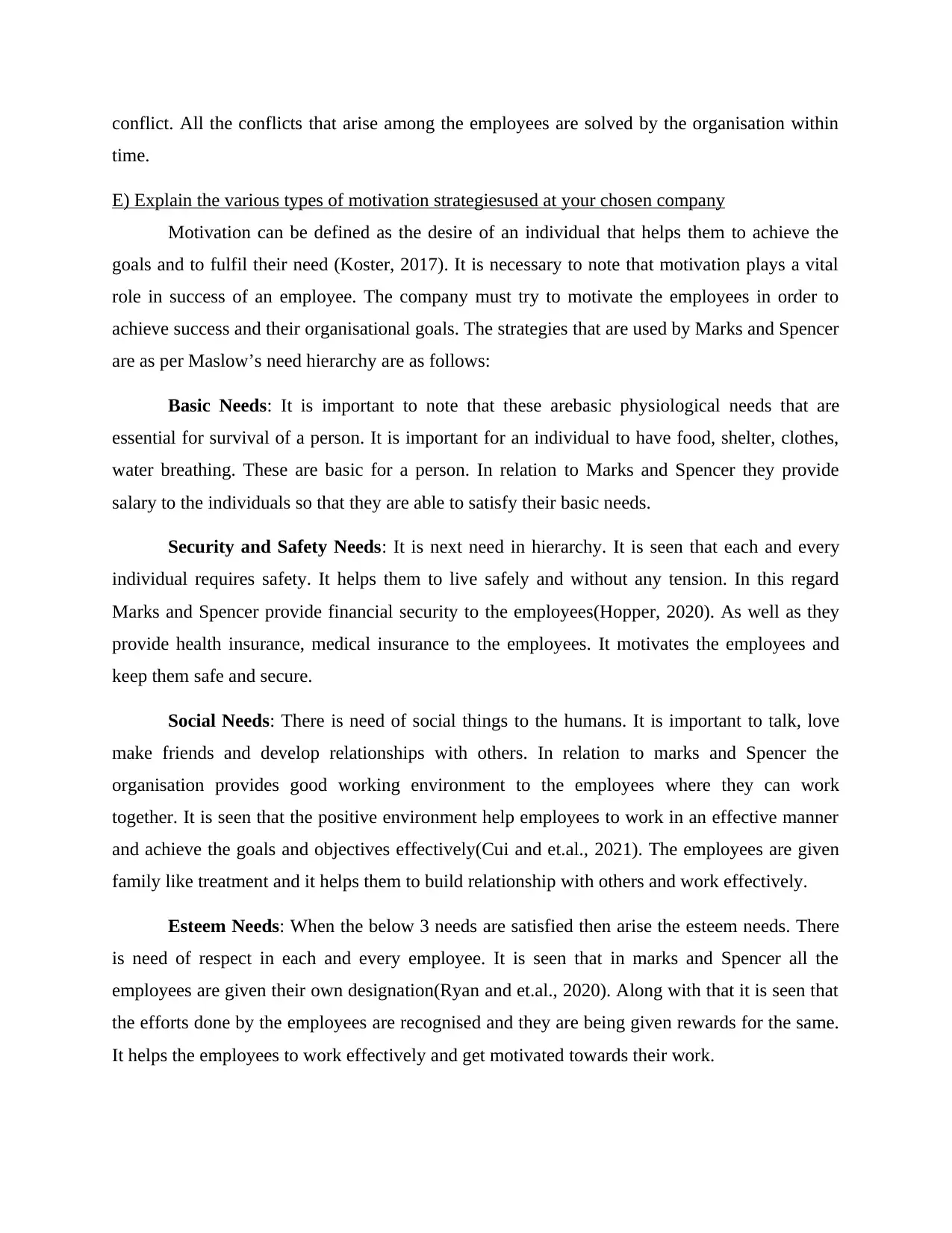
conflict. All the conflicts that arise among the employees are solved by the organisation within
time.
E) Explain the various types of motivation strategiesused at your chosen company
Motivation can be defined as the desire of an individual that helps them to achieve the
goals and to fulfil their need (Koster, 2017). It is necessary to note that motivation plays a vital
role in success of an employee. The company must try to motivate the employees in order to
achieve success and their organisational goals. The strategies that are used by Marks and Spencer
are as per Maslow’s need hierarchy are as follows:
Basic Needs: It is important to note that these arebasic physiological needs that are
essential for survival of a person. It is important for an individual to have food, shelter, clothes,
water breathing. These are basic for a person. In relation to Marks and Spencer they provide
salary to the individuals so that they are able to satisfy their basic needs.
Security and Safety Needs: It is next need in hierarchy. It is seen that each and every
individual requires safety. It helps them to live safely and without any tension. In this regard
Marks and Spencer provide financial security to the employees(Hopper, 2020). As well as they
provide health insurance, medical insurance to the employees. It motivates the employees and
keep them safe and secure.
Social Needs: There is need of social things to the humans. It is important to talk, love
make friends and develop relationships with others. In relation to marks and Spencer the
organisation provides good working environment to the employees where they can work
together. It is seen that the positive environment help employees to work in an effective manner
and achieve the goals and objectives effectively(Cui and et.al., 2021). The employees are given
family like treatment and it helps them to build relationship with others and work effectively.
Esteem Needs: When the below 3 needs are satisfied then arise the esteem needs. There
is need of respect in each and every employee. It is seen that in marks and Spencer all the
employees are given their own designation(Ryan and et.al., 2020). Along with that it is seen that
the efforts done by the employees are recognised and they are being given rewards for the same.
It helps the employees to work effectively and get motivated towards their work.
time.
E) Explain the various types of motivation strategiesused at your chosen company
Motivation can be defined as the desire of an individual that helps them to achieve the
goals and to fulfil their need (Koster, 2017). It is necessary to note that motivation plays a vital
role in success of an employee. The company must try to motivate the employees in order to
achieve success and their organisational goals. The strategies that are used by Marks and Spencer
are as per Maslow’s need hierarchy are as follows:
Basic Needs: It is important to note that these arebasic physiological needs that are
essential for survival of a person. It is important for an individual to have food, shelter, clothes,
water breathing. These are basic for a person. In relation to Marks and Spencer they provide
salary to the individuals so that they are able to satisfy their basic needs.
Security and Safety Needs: It is next need in hierarchy. It is seen that each and every
individual requires safety. It helps them to live safely and without any tension. In this regard
Marks and Spencer provide financial security to the employees(Hopper, 2020). As well as they
provide health insurance, medical insurance to the employees. It motivates the employees and
keep them safe and secure.
Social Needs: There is need of social things to the humans. It is important to talk, love
make friends and develop relationships with others. In relation to marks and Spencer the
organisation provides good working environment to the employees where they can work
together. It is seen that the positive environment help employees to work in an effective manner
and achieve the goals and objectives effectively(Cui and et.al., 2021). The employees are given
family like treatment and it helps them to build relationship with others and work effectively.
Esteem Needs: When the below 3 needs are satisfied then arise the esteem needs. There
is need of respect in each and every employee. It is seen that in marks and Spencer all the
employees are given their own designation(Ryan and et.al., 2020). Along with that it is seen that
the efforts done by the employees are recognised and they are being given rewards for the same.
It helps the employees to work effectively and get motivated towards their work.
⊘ This is a preview!⊘
Do you want full access?
Subscribe today to unlock all pages.

Trusted by 1+ million students worldwide
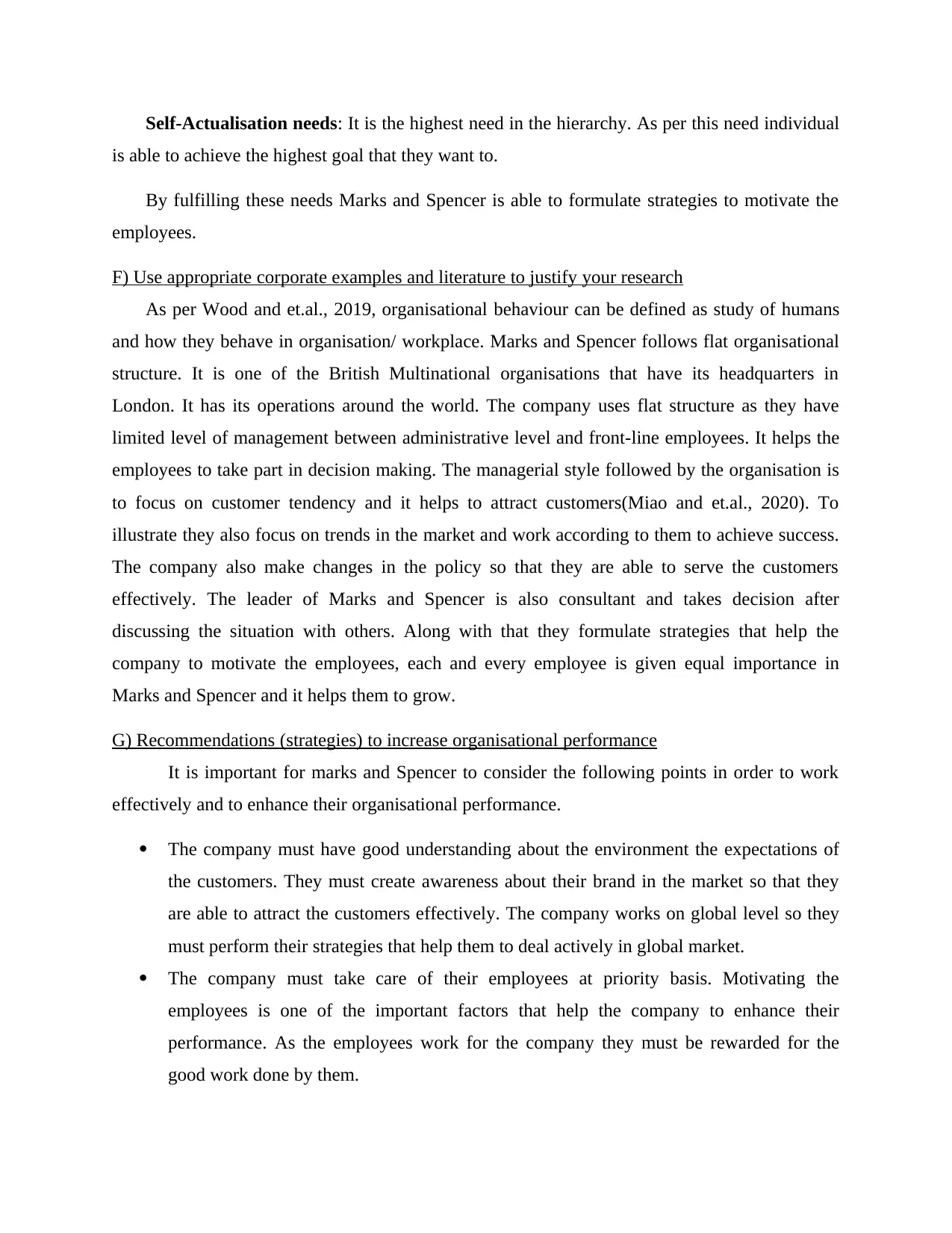
Self-Actualisation needs: It is the highest need in the hierarchy. As per this need individual
is able to achieve the highest goal that they want to.
By fulfilling these needs Marks and Spencer is able to formulate strategies to motivate the
employees.
F) Use appropriate corporate examples and literature to justify your research
As per Wood and et.al., 2019, organisational behaviour can be defined as study of humans
and how they behave in organisation/ workplace. Marks and Spencer follows flat organisational
structure. It is one of the British Multinational organisations that have its headquarters in
London. It has its operations around the world. The company uses flat structure as they have
limited level of management between administrative level and front-line employees. It helps the
employees to take part in decision making. The managerial style followed by the organisation is
to focus on customer tendency and it helps to attract customers(Miao and et.al., 2020). To
illustrate they also focus on trends in the market and work according to them to achieve success.
The company also make changes in the policy so that they are able to serve the customers
effectively. The leader of Marks and Spencer is also consultant and takes decision after
discussing the situation with others. Along with that they formulate strategies that help the
company to motivate the employees, each and every employee is given equal importance in
Marks and Spencer and it helps them to grow.
G) Recommendations (strategies) to increase organisational performance
It is important for marks and Spencer to consider the following points in order to work
effectively and to enhance their organisational performance.
The company must have good understanding about the environment the expectations of
the customers. They must create awareness about their brand in the market so that they
are able to attract the customers effectively. The company works on global level so they
must perform their strategies that help them to deal actively in global market.
The company must take care of their employees at priority basis. Motivating the
employees is one of the important factors that help the company to enhance their
performance. As the employees work for the company they must be rewarded for the
good work done by them.
is able to achieve the highest goal that they want to.
By fulfilling these needs Marks and Spencer is able to formulate strategies to motivate the
employees.
F) Use appropriate corporate examples and literature to justify your research
As per Wood and et.al., 2019, organisational behaviour can be defined as study of humans
and how they behave in organisation/ workplace. Marks and Spencer follows flat organisational
structure. It is one of the British Multinational organisations that have its headquarters in
London. It has its operations around the world. The company uses flat structure as they have
limited level of management between administrative level and front-line employees. It helps the
employees to take part in decision making. The managerial style followed by the organisation is
to focus on customer tendency and it helps to attract customers(Miao and et.al., 2020). To
illustrate they also focus on trends in the market and work according to them to achieve success.
The company also make changes in the policy so that they are able to serve the customers
effectively. The leader of Marks and Spencer is also consultant and takes decision after
discussing the situation with others. Along with that they formulate strategies that help the
company to motivate the employees, each and every employee is given equal importance in
Marks and Spencer and it helps them to grow.
G) Recommendations (strategies) to increase organisational performance
It is important for marks and Spencer to consider the following points in order to work
effectively and to enhance their organisational performance.
The company must have good understanding about the environment the expectations of
the customers. They must create awareness about their brand in the market so that they
are able to attract the customers effectively. The company works on global level so they
must perform their strategies that help them to deal actively in global market.
The company must take care of their employees at priority basis. Motivating the
employees is one of the important factors that help the company to enhance their
performance. As the employees work for the company they must be rewarded for the
good work done by them.
Paraphrase This Document
Need a fresh take? Get an instant paraphrase of this document with our AI Paraphraser
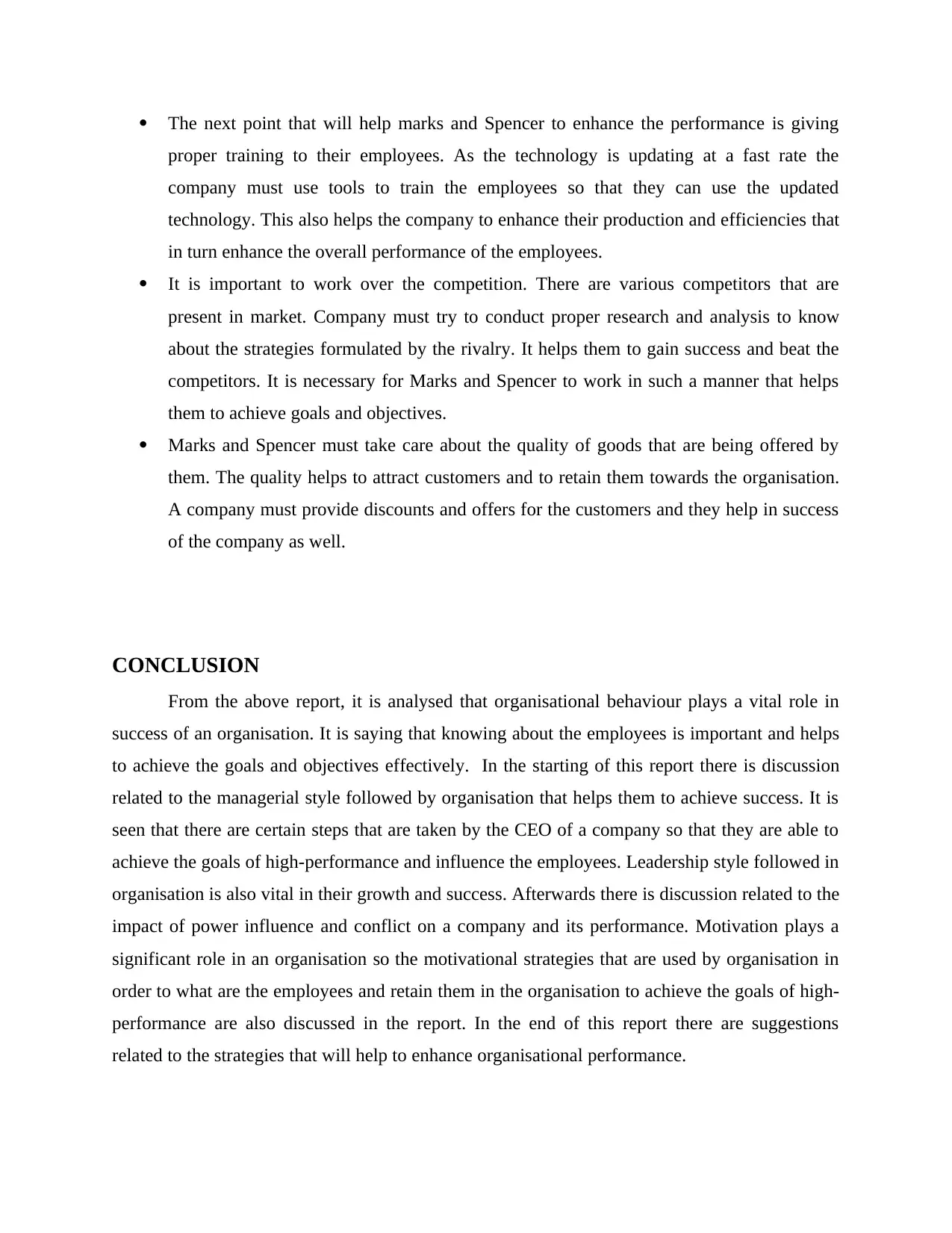
The next point that will help marks and Spencer to enhance the performance is giving
proper training to their employees. As the technology is updating at a fast rate the
company must use tools to train the employees so that they can use the updated
technology. This also helps the company to enhance their production and efficiencies that
in turn enhance the overall performance of the employees.
It is important to work over the competition. There are various competitors that are
present in market. Company must try to conduct proper research and analysis to know
about the strategies formulated by the rivalry. It helps them to gain success and beat the
competitors. It is necessary for Marks and Spencer to work in such a manner that helps
them to achieve goals and objectives.
Marks and Spencer must take care about the quality of goods that are being offered by
them. The quality helps to attract customers and to retain them towards the organisation.
A company must provide discounts and offers for the customers and they help in success
of the company as well.
CONCLUSION
From the above report, it is analysed that organisational behaviour plays a vital role in
success of an organisation. It is saying that knowing about the employees is important and helps
to achieve the goals and objectives effectively. In the starting of this report there is discussion
related to the managerial style followed by organisation that helps them to achieve success. It is
seen that there are certain steps that are taken by the CEO of a company so that they are able to
achieve the goals of high-performance and influence the employees. Leadership style followed in
organisation is also vital in their growth and success. Afterwards there is discussion related to the
impact of power influence and conflict on a company and its performance. Motivation plays a
significant role in an organisation so the motivational strategies that are used by organisation in
order to what are the employees and retain them in the organisation to achieve the goals of high-
performance are also discussed in the report. In the end of this report there are suggestions
related to the strategies that will help to enhance organisational performance.
proper training to their employees. As the technology is updating at a fast rate the
company must use tools to train the employees so that they can use the updated
technology. This also helps the company to enhance their production and efficiencies that
in turn enhance the overall performance of the employees.
It is important to work over the competition. There are various competitors that are
present in market. Company must try to conduct proper research and analysis to know
about the strategies formulated by the rivalry. It helps them to gain success and beat the
competitors. It is necessary for Marks and Spencer to work in such a manner that helps
them to achieve goals and objectives.
Marks and Spencer must take care about the quality of goods that are being offered by
them. The quality helps to attract customers and to retain them towards the organisation.
A company must provide discounts and offers for the customers and they help in success
of the company as well.
CONCLUSION
From the above report, it is analysed that organisational behaviour plays a vital role in
success of an organisation. It is saying that knowing about the employees is important and helps
to achieve the goals and objectives effectively. In the starting of this report there is discussion
related to the managerial style followed by organisation that helps them to achieve success. It is
seen that there are certain steps that are taken by the CEO of a company so that they are able to
achieve the goals of high-performance and influence the employees. Leadership style followed in
organisation is also vital in their growth and success. Afterwards there is discussion related to the
impact of power influence and conflict on a company and its performance. Motivation plays a
significant role in an organisation so the motivational strategies that are used by organisation in
order to what are the employees and retain them in the organisation to achieve the goals of high-
performance are also discussed in the report. In the end of this report there are suggestions
related to the strategies that will help to enhance organisational performance.
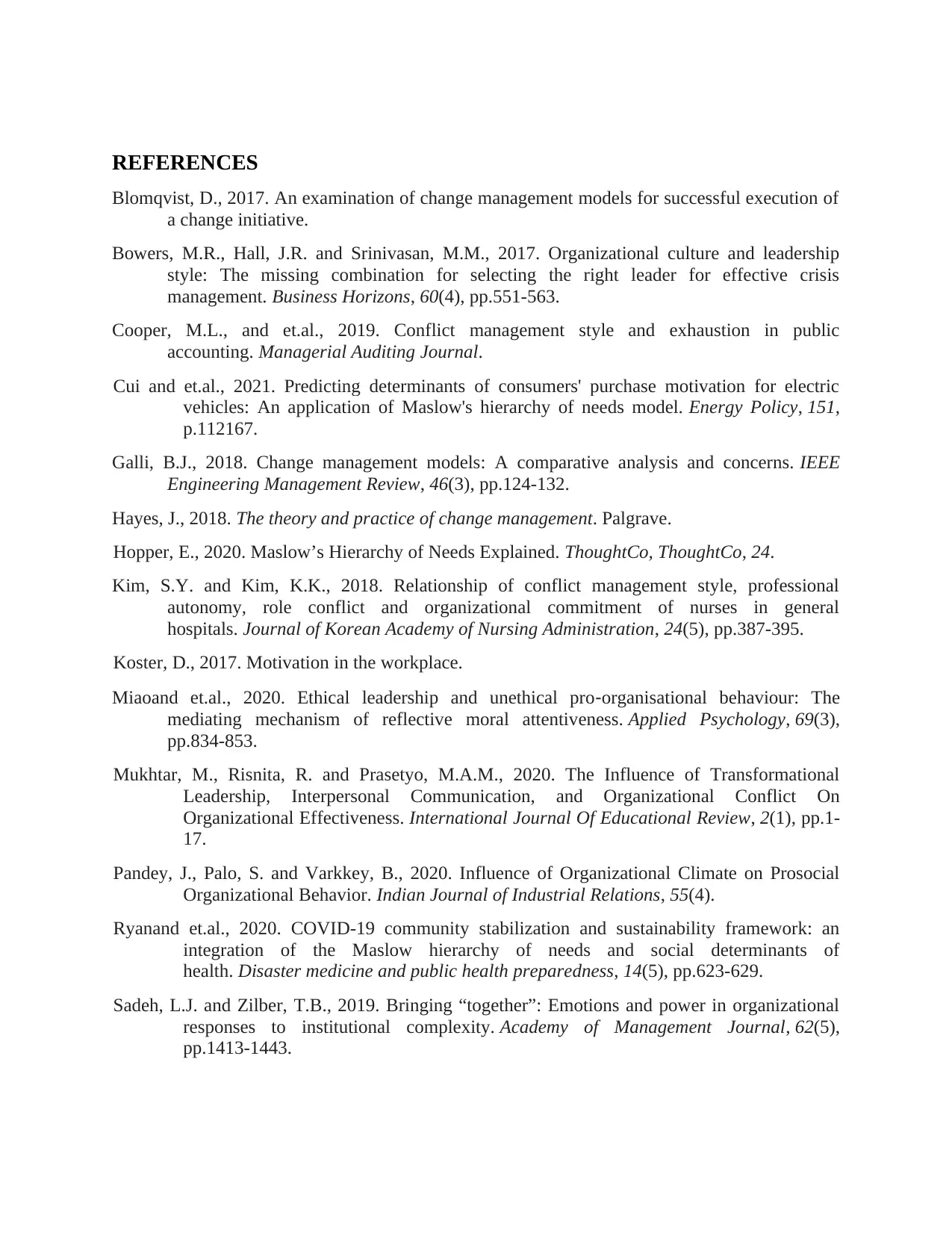
REFERENCES
Blomqvist, D., 2017. An examination of change management models for successful execution of
a change initiative.
Bowers, M.R., Hall, J.R. and Srinivasan, M.M., 2017. Organizational culture and leadership
style: The missing combination for selecting the right leader for effective crisis
management. Business Horizons, 60(4), pp.551-563.
Cooper, M.L., and et.al., 2019. Conflict management style and exhaustion in public
accounting. Managerial Auditing Journal.
Cui and et.al., 2021. Predicting determinants of consumers' purchase motivation for electric
vehicles: An application of Maslow's hierarchy of needs model. Energy Policy, 151,
p.112167.
Galli, B.J., 2018. Change management models: A comparative analysis and concerns. IEEE
Engineering Management Review, 46(3), pp.124-132.
Hayes, J., 2018. The theory and practice of change management. Palgrave.
Hopper, E., 2020. Maslow’s Hierarchy of Needs Explained. ThoughtCo, ThoughtCo, 24.
Kim, S.Y. and Kim, K.K., 2018. Relationship of conflict management style, professional
autonomy, role conflict and organizational commitment of nurses in general
hospitals. Journal of Korean Academy of Nursing Administration, 24(5), pp.387-395.
Koster, D., 2017. Motivation in the workplace.
Miaoand et.al., 2020. Ethical leadership and unethical pro‐organisational behaviour: The
mediating mechanism of reflective moral attentiveness. Applied Psychology, 69(3),
pp.834-853.
Mukhtar, M., Risnita, R. and Prasetyo, M.A.M., 2020. The Influence of Transformational
Leadership, Interpersonal Communication, and Organizational Conflict On
Organizational Effectiveness. International Journal Of Educational Review, 2(1), pp.1-
17.
Pandey, J., Palo, S. and Varkkey, B., 2020. Influence of Organizational Climate on Prosocial
Organizational Behavior. Indian Journal of Industrial Relations, 55(4).
Ryanand et.al., 2020. COVID-19 community stabilization and sustainability framework: an
integration of the Maslow hierarchy of needs and social determinants of
health. Disaster medicine and public health preparedness, 14(5), pp.623-629.
Sadeh, L.J. and Zilber, T.B., 2019. Bringing “together”: Emotions and power in organizational
responses to institutional complexity. Academy of Management Journal, 62(5),
pp.1413-1443.
Blomqvist, D., 2017. An examination of change management models for successful execution of
a change initiative.
Bowers, M.R., Hall, J.R. and Srinivasan, M.M., 2017. Organizational culture and leadership
style: The missing combination for selecting the right leader for effective crisis
management. Business Horizons, 60(4), pp.551-563.
Cooper, M.L., and et.al., 2019. Conflict management style and exhaustion in public
accounting. Managerial Auditing Journal.
Cui and et.al., 2021. Predicting determinants of consumers' purchase motivation for electric
vehicles: An application of Maslow's hierarchy of needs model. Energy Policy, 151,
p.112167.
Galli, B.J., 2018. Change management models: A comparative analysis and concerns. IEEE
Engineering Management Review, 46(3), pp.124-132.
Hayes, J., 2018. The theory and practice of change management. Palgrave.
Hopper, E., 2020. Maslow’s Hierarchy of Needs Explained. ThoughtCo, ThoughtCo, 24.
Kim, S.Y. and Kim, K.K., 2018. Relationship of conflict management style, professional
autonomy, role conflict and organizational commitment of nurses in general
hospitals. Journal of Korean Academy of Nursing Administration, 24(5), pp.387-395.
Koster, D., 2017. Motivation in the workplace.
Miaoand et.al., 2020. Ethical leadership and unethical pro‐organisational behaviour: The
mediating mechanism of reflective moral attentiveness. Applied Psychology, 69(3),
pp.834-853.
Mukhtar, M., Risnita, R. and Prasetyo, M.A.M., 2020. The Influence of Transformational
Leadership, Interpersonal Communication, and Organizational Conflict On
Organizational Effectiveness. International Journal Of Educational Review, 2(1), pp.1-
17.
Pandey, J., Palo, S. and Varkkey, B., 2020. Influence of Organizational Climate on Prosocial
Organizational Behavior. Indian Journal of Industrial Relations, 55(4).
Ryanand et.al., 2020. COVID-19 community stabilization and sustainability framework: an
integration of the Maslow hierarchy of needs and social determinants of
health. Disaster medicine and public health preparedness, 14(5), pp.623-629.
Sadeh, L.J. and Zilber, T.B., 2019. Bringing “together”: Emotions and power in organizational
responses to institutional complexity. Academy of Management Journal, 62(5),
pp.1413-1443.
⊘ This is a preview!⊘
Do you want full access?
Subscribe today to unlock all pages.

Trusted by 1+ million students worldwide
1 out of 13
Related Documents
Your All-in-One AI-Powered Toolkit for Academic Success.
+13062052269
info@desklib.com
Available 24*7 on WhatsApp / Email
![[object Object]](/_next/static/media/star-bottom.7253800d.svg)
Unlock your academic potential
Copyright © 2020–2025 A2Z Services. All Rights Reserved. Developed and managed by ZUCOL.



